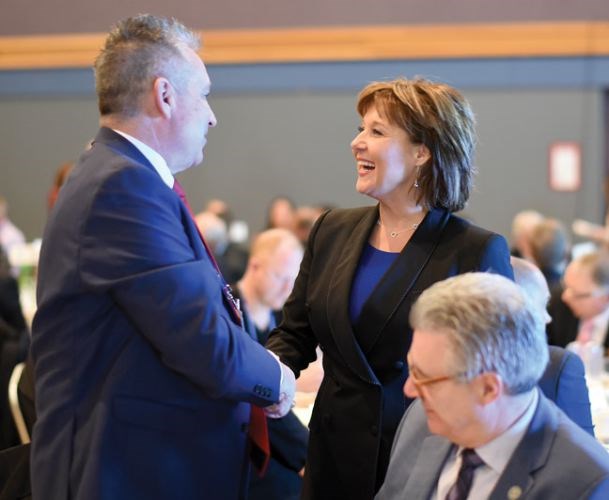High-tech and all-natural will soon be hammered together at a new building in downtown Prince George.
Futuristic forestry has a new home on the national landscape.
A customized laboratory and research centre is on the way, especially designed to test the structural properties and alternative possibilities of wood.
Some of this work is already being done at the Wood Innovation and Design Centre (WIDC), where the Emily Carr University of Art + Design has a wood-focused education and creation program, and UNBC has a pair of masters-level wood engineering programs. The new Wood Innovation Research Lab (WIRL) will be built right beside it.
Inside, UNBC will consolidate its other educational programs that involve wood technologies, creating a power centre for the research and development on the cutting edge of the forest industry.
Premier Christy Clark made the announcement on Wednesday at the B.C. Natural Resource Forum held at the Prince George Civic Centre.
She said UNBC president Daniel Weeks had been envisioning the place probably as long as he has been in his position and government actively joined the plan about a year ago.
That included successfully lobbying the federal government which eventually agreed to invest about half of the $4.5 million needed to create the facility.
The City of Prince George is contributing the land on which it will be built.
"We are very grateful the feds stepped up. That's really, I think, what clinched the deal," said Clark.
"The other part of it is, the WIDC has been so successful we need to now grow it. Contrary to what critics of it at the time said, it is already too full."
The event was a province-wide gathering of heavy hitters in the worlds of forestry, mining, petroleum, and other natural resource sub-sectors. It was a place where economic diversity was frequently on the discussion table, and part of that was talking about the technology sector.
Some suggested the tech sector was sequestered to the Lower Mainland and was driving the majority of the economic health B.C. is currently enjoying, after a couple of years of low commodity prices slowed the sales of wood, minerals, energy products, etc.
It was an eye-rolling point of discussion for Weeks, who had only to point to this WIRL announcement as the latest evidence.
"There's always that moment where you wish you could just grab the mic," he said with a laugh. "Anyone who thinks forestry or any of the resource industries isn't high-tech doesn't understand what's going on. We're working with the forest industry, taking those forest products, and looking at them in the most high tech ways you can imagine. This is extraordinarily high-tech. Our (UNBC) scientists are looking at how to build with wood in ways that are strong as titanium and steel. This is way ahead of the curve - way ahead."
Add to that the research being done in Prince George on how to turn the microscopic building blocks of trees into vehicle fuel and other unexpected public uses, and you have the common tree standing as the new frontier of technology, said Weeks.
"After we launched the (WIDC) program, what we found out very, very quickly was, to really take it to the next level, we needed what we call a high-head lab," Weeks explained.
"Much like this room right here (the Civic Centre, with its cavernous ceilings) so our students could build not just models but actually build large-scale structures. You can't do that in just any building. It has to be purpose-made. It will really integrate with the spaces we have there already."
Clark said it was an investment in the forest industry, and its paradigm-smashing future, but it was also an effort in spreading economic diversification to regions outside the Vancouver-Victoria cluster.
"We need to have a rural technology strategy which we are already seeing in many places in the province," the premier said.
"In many small towns, with the very attractive lifestyle you have outside the urban areas, are really attracting a lot of tech. We just need to make sure the infrastructure is there, and most importantly, that the talent is there. That means investing in technology-related programs at universities and colleges and even in high schools that are well distributed across the province, not just in the Lower Mainland."
The new WIRL building is expected to be complete about a year from now. It will add another spark of economic traffic to the George Street area of town.
"The City of Prince George is providing the land for this new lab because we believe so strongly in the partnership that the city has with UNBC," said Mayor Lyn Hall, on hand for the announcement.
"Attracting more students downtown is critical to our revitalization efforts and enhancing Prince George's capacity for forest product innovation is perfectly aligned with our economic development strategy. Thank you to the governments of Canada and British Columbia for joining with us to realize this great opportunity for Prince George."



